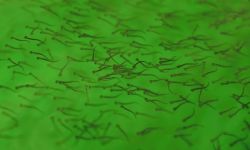Road salt, a stealthy pollutant, is damaging Michigan waters

- Road salt is sullying Michigan’s lakes and streams
- Despite known hazards, salt use continues to increase
- Michigan has no plan for limiting salt pollution
In a dim hangar outside of Traverse City, towering piles of white crystals cast a glow in the twilight.
Salts like those stored at the Grand Traverse County Road Commission maintenance facility keep Michigan roads, parking lots, and sidewalks clear of ice in the winter, a prudent safety measure for motorists and pedestrians. The mobility benefits of salt for a car-centric society, though, have an undesirable environmental side effect that has built up over decades of use: extensive damage to ecosystems and infrastructure.
Refresh
This story is part of a Great Lakes News Collaborative series investigating the Great Lakes region’s water pollution challenges. Called Refresh, the series explores the Clean Water Act’s shortcomings in the Great Lakes, and how the region can more completely address water pollution in the next 50 years.
The collaborative’s four newsrooms — Bridge Michigan, Circle of Blue, Great Lakes Now, and Michigan Radio — are funded by the Charles Stewart Mott Foundation.
Chloride -- the catch-all term for salts -- does not discriminate. It hurts mayflies and freshwater mussels, taking out species at the base of the freshwater food chain. It acts as a chemical instigator, loosening metals and nutrients that are otherwise bound in sediment and freeing them to flow downstream, thus feeding toxic algae in troubled places like Lake Erie. As with sun on skin, excess salt accelerates infrastructure aging. The metals and concrete in bridges, roads, and cars deteriorate faster when exposed to salts.
Related:
- A Grand Rapids lake and the consequences of Michigan’s road salt addiction
- Road salt threatens Michigan lakes and rivers. Can an alternative take hold?
The state issued its first water quality standards for chloride in 2019. Not written with infrastructure in mind, the standards are intended to protect fish, insects, and other freshwater species. But the state has not yet translated those standards into a plan for limiting chloride in the eight stream sections that already exceed the limit.
Developing those pollution diets takes years. In the interim, state regulators this year are directly asking municipalities with storm sewer systems to outline steps for controlling salt runoff from roads. Roads, however, are only part of the problem. Salt applied to parking lots and sidewalks also enters streams and groundwater. But regulators say that municipalities do not have the staff or budgets to oversee salt application on private property. In part, this is a consequence of state court rulings that have deterred cities from creating agencies to manage pollutants that are flushed from paved surfaces.
The best way to deal with salt pollution is to bar it entry -- not to allow it in the water in the first place. By and large, that outcome will rely on the widespread and voluntary adoption of salt-reducing practices by road agencies, shopping mall owners, apartment complex managers, and homeowners. Reducing salt use also hinges on societal shifts: public acceptance in urban areas of slower winter driving speeds and less driving in hazardous weather.
“You can think of chloride as a permanent pollutant in the water,” said Christe Alwin of the Michigan Department of Environment, Great Lakes, and Energy. “Once it’s there, there’s very little opportunity to treat it.”

Last year marked the 50th anniversary of the Clean Water Act, the landmark federal law that intended to give new life to waterways that were fouled by all manner of chemical and bacterial pollutants. The goal was to make rivers and lakes fishable and swimmable once again. The law, part of a package of national environmental reforms in the early 1970s, was transformative. By mandating pollution controls on wastewater treatment plants and industrial facilities, it marked a new era of environmental stewardship -- an era in which rivers and lakes were viewed not as dumping grounds but as civic assets that fostered recreation, ecological rebirth, and economic development.
Despite undeniable progress, substantial impediments to clean water remain. The law did little to stanch the flow of dispersed pollution that comes from roads, lawns, and farms. More waters today are fishable and swimmable, particularly in major metropolitan regions. But many, especially streams and rivers that drain agricultural regions, still are not. The consequences are measured in toxic algal bloom dead zones, human sickness, and the rising cost of water treatment.
Urban Areas on a High-Sodium Diet
A little salt can cause a lot of harm. The U.S. Environmental Protection Agency recommends water quality standards for rivers and lakes to prevent death and damage to fish, mussels, insects, and other aquatic species. For chloride, the EPA determined the threshold at which long-term damage could occur to be 230 milligrams per liter. That equals about one teaspoon of salt in five gallons of water.
Michigan has been slow to react to the salinization of its fresh water. The Department of Environment, Great Lakes, and Energy finalized water quality values for chloride only in 2019, three decades after the federal EPA published guidelines. Based on the numbers, EGLE determined last year that eight stream sections exceed the state threshold for chronic exposure, which is 150 milligrams per liter.
Those streams -- largely in the urban areas of southeast Michigan -- include the Shiawassee River (Genesee County), Thread Creek (Genesee County), Sashabaw Creek (Oakland County), Bishop Creek and the Upper Rouge River (Rouge River watershed), Belle River (St. Clair County), Rush Creek (Ottawa County), and County Line Drain (Arenac/Iosco County), which also exceeded the sulfate standard.
The next step for those stream sections is a regulatory tool known as a total maximum daily load, or TMDL, which caps pollution discharges. However, there is no timeline yet for developing the pollution diet for those streams, according to Kevin Goodwin, an aquatic biology specialist at EGLE.
It’s no mystery where most of the salts are coming from. Water softeners and fertilizers are sources of chloride, but the major contributor, Goodwin and others said, are the salts spread on roads, parking lots, and sidewalks to keep the pavement free from ice.
Salinization of streams is a problem across the United States, where at least 20 million tons of salt were used in 2021 for highway deicing. The U.S. Geological Survey studied 19 streams in eight states and the District of Columbia, including five Great Lakes states. The researchers found that chloride levels related to road salt increased in 84 percent of sampled streams. Increases were especially notable in urban areas with a large percentage of paved surfaces.
Those findings have been replicated at the state and local level. EGLE found chloride hot spots that align with high concentrations of highways and housing developments. The Huron River, a 900-square-mile watershed in southeast Michigan that flows through Ann Arbor, is one such area. For the last two decades the Huron River Watershed Council has tested streams for pollutants. Volunteers and staff now regularly take water samples from about 40 or 50 sites in the watershed, according to Ric Lawson, a watershed planner.
“We see that we have much higher [chloride] levels in our urban drainages,” Lawson said.
Following up on its stream samples, the Huron River Watershed Council did additional investigation at sites with abnormally high chloride levels. Were those salts coming from a particular source? Were there, as Lawson put it, any “smoking guns?”
In short, the council didn’t find any -- no leakage from a salt storage facility, no obvious surface runoff. No smoking guns. “So it does appear it’s been broad-based, long-term application,” Lawson said, referring to the salt source. “And probably, the salts moving through groundwater are how it's getting to the surface waters.”
Broad-based is the classic definition of non-point pollution. It’s the type of threat that the Clean Water Act, which focused on pollution coming from a pipe, is not at all equipped to address. The law exempts most sources of such pollution from regulation and oversight. That’s why non-point pollution is a long-term problem. Curbing it requires, in the case of salt, a voluntary change in practices.
Less Bounce, Less Scatter
Michigan’s ground transportation network is a lattice of roughly 122,000 miles of roads. To maintain these surfaces, the state’s road agencies balance three competing objectives, said Gregg Brunner, director of the Bureau of Field Services for the Michigan Department of Transportation (MDOT). Mobility, cost, and environmental protection.
Salt -- the sodium chloride form, in fact -- is the cheapest, most effective deicing agent available, Brunner said. On that measure it beats out magnesium chloride and potassium chloride.
A non-chloride option -- calcium magnesium acetate -- is on the market. But it costs about 40 times more than sodium chloride, which is mined locally, from deposits beneath Lake Erie.
The primary objective for MDOT and other road maintenance agencies is to use less of it. In pursuit of that goal, they participated in a work group to help EGLE develop salt management guidelines. Published in 2021, the guidelines are a compilation of voluntary “best management practices” that road agencies should strive to implement. The County Road Association of Michigan, which represents the 83 county road agencies, published a similar guide based on a survey of its members.
A major emphasis is to minimize waste, or salt’s “bounce and scatter.” One way of doing that is to dampen the salt with water before it is spread on the highway. Pre-wetting occurs in most MDOT facilities and the department recommends that county and city agencies do the same.
Another tactic is to slow down. Brunner says to picture someone dropping a handful of rocks out of a moving car. “If you're going fast, those are all going to shoot off and go in the ditch,” he says. Too much bounce, too much scatter. By pre-wetting and reducing the speed of salt-spreading trucks to 20 to 25 miles per hour, more salt is kept on the roadway.
These techniques and others have yielded measureable results. Decades ago road agencies used 500 pounds of salt per lane-mile to deice a highway. Now, according to the County Road Association, the figure has been cut in half.
Other innovations are being tested. Lawmakers ordered MDOT to experiment with mixtures of agricultural waste -- items like sugar beets, corn molasses, or sugar cane -- that are blended into a liquid deicer that can be sprayed on roads. The five-year pilot project is underway in three counties, and a final report is expected in 2025.
“We're kind of learning as we go,” Brunner said about the pilot project. “Adjusting those different types of materials and percentages till we find hopefully that sweet spot down the road.”
Like the shift from fossil fuels to renewables, the transition to low-salt practices entails an upfront capital cost. Different equipment is needed to enable targeted salt application. It’s not cheap, says Steve Puuri, an engineering specialist for the County Road Association of Michigan. A new truck might cause $250,000. Replacing a fleet of dozens quickly gobbles a budget.
For now, EGLE is focusing its efforts on road agencies that are regulated through stormwater permits. This MS4 program affects municipalities in urbanized southern Michigan, where chloride in streams is highest. This year, EGLE is asking municipalities for more details on how they will control road salt runoff. What is the salting strategy before a storm? During a storm? Are they targeting only high-traffic areas? “We're continuing to refine our expectations based on new technologies,” said Alwin, who is with EGLE’s stormwater permits unit.

More could be done to reduce salt loads from private property, Alwin said, but Michigan does not have the legal tools of other cold-region states.
New Hampshire, in 2013, enacted a certification and training program for companies that provide salting services. Businesses that hire a certified company to maintain their parking lots in winter have limited liability against slip-and-fall accidents that might occur on the premises. The thinking is that private property owners apply excessive amounts of salt because they fear being sued. Advocates have proposed similar legislation in Minnesota, where 50 water bodies exceed the state chloride limit.
Another disadvantage in Michigan relates to the structure of local governments. In many states, municipalities have a separate agency called a stormwater utility that is tasked with managing runoff from roads and parking lots. Nationally, according to a Western Kentucky University database, there are more than 2,000 stormwater utilities. In Michigan, however, there are only 12.
Political observers attribute the scarcity to the Bolt opinion, a Michigan Supreme Court decision in 1998 that established a three-part test for determining when a municipal “fee” was in fact a “tax” that required voter approval. According to Greg Kacvinsky, who works on stormwater issues for OHM Advisors, an engineering consultancy, the Bolt ruling and a subsequent court affirmation “scared away” communities from setting up stormwater units.
“Michigan communities, without having the safe, legal means to establish stormwater utilities, find it difficult to raise revenue to pay for infrastructure improvements to clean up stormwater before it reaches rivers and lakes,” Kacvinsky said.
Lawmakers proposed bills in previous legislative sessions to clarify the legal authority for municipalities to establish stormwater utilities. In Republican-controlled chambers, those bills always met a dead end.
The situation has reversed. After a power-shift election, Democrats control the House, Senate, and governor’s office for the first time since 1983.
Stormwater will be part of a crowded legislative agenda in Lansing. But having that trifecta, Kacvinsky said, means a greater likelihood of passing legislation to control pollution from paved surfaces.
Michigan Environment Watch
Michigan Environment Watch examines how public policy, industry, and other factors interact with the state’s trove of natural resources.
- See full coverage
- Subscribe
- Share tips and questions with Bridge environment reporter Kelly House
Michigan Environment Watch is made possible by generous financial support from:
Our generous Environment Watch underwriters encourage Bridge Michigan readers to also support civic journalism by becoming Bridge members. Please consider joining today.
See what new members are saying about why they donated to Bridge Michigan:
- “In order for this information to be accurate and unbiased it must be underwritten by its readers, not by special interests.” - Larry S.
- “Not many other media sources report on the topics Bridge does.” - Susan B.
- “Your journalism is outstanding and rare these days.” - Mark S.
If you want to ensure the future of nonpartisan, nonprofit Michigan journalism, please become a member today. You, too, will be asked why you donated and maybe we'll feature your quote next time!






